Removing your unwanted spots, discolored pigment and freckles is easier than you think!
If you really want those offending brown spots gone, the good news is, that there are a variety of solutions. Brown spots are usually benign and won’t cause any health problems, but it is important to pay attention to any spot that changes in color, size or texture and to see your dermatologist regularly. While treatment for benign spots isn’t necessary, removal/fading can be cosmetically and psychologically rewarding. After all, who wouldn’t want a clearer, more even skin tone?
What should I know about spots?
Brown spots are also called age spots, liver spots, solar lentigines, or sun spots. These spots are flat, oval areas of increased pigmentation that vary in size. Usually gray, tan, brown or black, spots appear on areas on your skin where you’ve had the most sun exposure over the years, such as your face, the backs of hands, tops of feet, forearms, shoulders and upper back, regardless of your sex or race. Although, brown spots are more common if you have fair skin, a history of frequent sun exposure, frequent tanning bed use, and are older than 40, may cause brown spots to show on your face.
What causes spots?
Brown spots are the result of overactive pigment cells, called melanocytes. Ultraviolet (UV) light speeds up the production of melanin, or skin pigment which results in darker skin, or a tan. After years of exposure to UV light, melanin becomes clumped together, or is produced in high concentrations, brown spots will appear.
There are three main types of benign skin pigmentation caused by overactive melanocytes. Freckles, solar lentigines and melasma.
Freckles
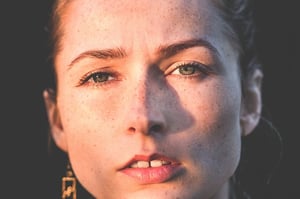 Think of freckles as a genetic gift from Mother Nature. A freckle is a small, pale to dark brown flat area. They are caused by overproduction of melanin in direct response to UV light exposure. Real freckles are most commonly found on younger skin from childhood, on people with red hair and pale skin that can burn easily. Freckles are more prominent on sun exposed areas during the summer months and tend to fade during the winter season.
Think of freckles as a genetic gift from Mother Nature. A freckle is a small, pale to dark brown flat area. They are caused by overproduction of melanin in direct response to UV light exposure. Real freckles are most commonly found on younger skin from childhood, on people with red hair and pale skin that can burn easily. Freckles are more prominent on sun exposed areas during the summer months and tend to fade during the winter season.
Solar lentigines
Solar lentigines are dark spots that result from prolonged sun exposure and are typically harmless. They are flat, 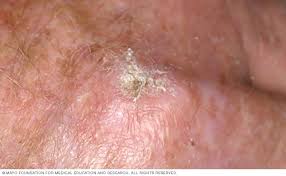 yellowish, grey or light brown lesions with a clearly defined edge. Some may have a dry or slightly scaly surface. Lentigines are larger and more defined than freckles found on your face, hands and chest that accumulate as you age as a result of sun exposure. They will not fade in winter months, can occur anywhere on your body and are usually benign.
yellowish, grey or light brown lesions with a clearly defined edge. Some may have a dry or slightly scaly surface. Lentigines are larger and more defined than freckles found on your face, hands and chest that accumulate as you age as a result of sun exposure. They will not fade in winter months, can occur anywhere on your body and are usually benign.
Another type of sun damage that can potentially be cancerous is Actinic Keratosis. Rather than dark and looking like a freckle, these spots are flat or slightly raised, reddish-brown, a bit more abrasive-looking and sometimes scaly. Surprisingly, nearly 60 million Americans have this type of sun damage to their skin.
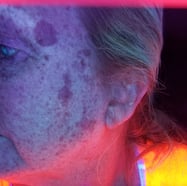 With a Woods Lamp (black light) evaluation, we can see cumulative damage before it becomes visible to the naked eye. It can be surprising to see what the sun has already done. There’s always a possibility that new lesions will emerge in the future, so the best prevention is to avoid the sun, use a broad-spectrum high factor sunscreen, and wear protective clothing and hats.
With a Woods Lamp (black light) evaluation, we can see cumulative damage before it becomes visible to the naked eye. It can be surprising to see what the sun has already done. There’s always a possibility that new lesions will emerge in the future, so the best prevention is to avoid the sun, use a broad-spectrum high factor sunscreen, and wear protective clothing and hats.
Melasma
If you have a Mediterranean-type olive complexion, are of Latin, Asian, or Middle Eastern descent, you are far more likely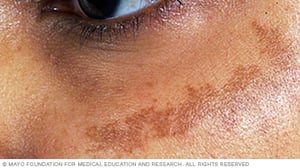 to develop Melasma. The large dark patches of pigmentation caused by overactive melanocytes may appear as mask-like patches on the cheeks, temples, above the upper lip and/or forehead. Excessive or repeated sun exposures as well as hormonal changes are believed to play a role in Melasma. It may develop if you’re taking birth control pills or hormone replacement therapy or are pregnant (also why it’s called a ‘pregnancy mask’). Although it may appear unsightly, the condition is not dangerous, nor does it cause any physical discomfort.
to develop Melasma. The large dark patches of pigmentation caused by overactive melanocytes may appear as mask-like patches on the cheeks, temples, above the upper lip and/or forehead. Excessive or repeated sun exposures as well as hormonal changes are believed to play a role in Melasma. It may develop if you’re taking birth control pills or hormone replacement therapy or are pregnant (also why it’s called a ‘pregnancy mask’). Although it may appear unsightly, the condition is not dangerous, nor does it cause any physical discomfort.
Another type of brown spot called post-inflammatory 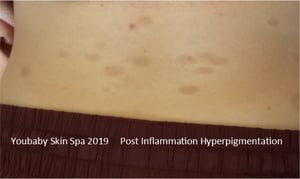 hyperpigmentation (PIH), is a result of an injury to the skin. PIH is more common in people with darker skin tones and show up as patches triggered by inflammation from skin conditions such as acne, eczema, or trauma. PIH leaves dark spots after the condition clears that may or may not fade over time.
hyperpigmentation (PIH), is a result of an injury to the skin. PIH is more common in people with darker skin tones and show up as patches triggered by inflammation from skin conditions such as acne, eczema, or trauma. PIH leaves dark spots after the condition clears that may or may not fade over time.
Words of caution and when you should see a doctor
Spots that are darkly pigmented or have changed in appearance, rapid increase in size, have an irregular border, an unusual combination of colors or if there is itching, redness, tenderness or bleeding. These changes can be signs of melanoma, a serious form of skin cancer. You should see your dermatologist right away! You should have a complete body spots check annually.
What spots can be treated?
Brown spots, including liver spots, freckles, solar lentigines and other benign pigmented lesions that appear on the skin after years of fun in the sun can be removed or faded from nearly any area on your body. Melasma, brown spots and patches resulting from sun exposure as well as areas affected by post inflammatory hyperpigmentation can be effectively treated as well. Actinic keratoses and abnormal -looking lesions should be treated by a physician.
Types of spot treatments
Since the pigment is located at the base of the epidermis — the top-most layer of skin — any treatments meant to lighten the spots must penetrate this layer of skin.
- Medications and prescription lightening creams that contains hydroquinone or kojic acid ( pigment bleaching agents) used alone or with retinoids (tretinoin) and a mild steroid may gradually fade the spots over several months.
- The treatments may result in temporary itching, redness, burning or dryness.
- Use of a broad-spectrum sunscreen with a sun protection factor (SPF) of at least 30 is essential if you use medication treatments.
- FotoFacial or IPL (intense pulsed light) treatment emits a range of light waves that passes through the skin and targets melanin to destroy or breakup the spots without damage to the skin's surface. Treatments typically require two to three sessions.
- After treatment, within days, the spots appear like coffee ground speckles that flake off and gradually fade over several weeks or months.
- You need to be out of the sun at least 4 weeks prior to treatment and use sun protection liberally after FotoFacial treatment to assure the best results.
- Freezing, or cryotherapy injures the cells in the spots by freezing them. Liquid nitrogen or another freezing agent is applied to the spots to destroy the extra pigment. Treatment can be painful, but it’s quick.
- After treatment, you may have some pain, a blister, or temporary redness and swelling.
- As the area heals, the skin appears lighter. Freezing is typically used on a single brown spot or a small grouping of spots.
- This treatment may temporarily irritate the skin, and poses a slight risk of permanent darkening of a spot (PIH), lightening of the skin around the age spot, or a scar.
- Chemical peel removes the outer layer of your skin so new skin can grow in its place. A chemical peel involves applying an acid, that essentially burns the outer layer of your skin, to the spots. As your skin peels, new skin forms to take its place. Several treatments may be necessary before you notice any results.
- Sun protection is strongly advised following this treatment.
- Temporary redness is likely, and there's a slight risk of permanent changes in skin color.
- Read more about the Cosmelan Depigmentation Treatment that we use at youbaby Skin Spa.
- Microdermabrasion is a less aggressive approach to smooth off the outer layers of the skin so new skin can grow in its place. Spots are smoothed away by the exfoliating action of inert crystals that removes the surface layer of your skin that leaves mild skin blemishes with a smoother appearance. You'll need a series of procedures over months to get the full effect.
- This treatment is not recommended if you have rosacea or tiny red veins on your face.
- After a microdermabrasion treatment, you may see mild redness that will likely disappear in a few hours and may have flaky skin for 3 or 4 days. This can be quite effective spot removal treatment, especially when done in conjunction with a chemical peel.
- Non-ablative Laser Spot Removals. Lasers destroy melanocytes without damaging the skin’s surface. At youbaby, we use a picosecond laser and PICO Genesis Spot treatments, that sends light at a trillionth of a second deep into the skin. The melanocytes are broken up and set free into the body’s lymphatic system to be eliminated.
- The treated area will darken, may even look a little bruised in color and may form a crust lasting for a few days, and fades over the next several weeks. The spots are lightened and the skin's texture is also improved.
- Several treatments are recommended. Each treatment builds upon the one before as the cells in the skin regenerate collagen production and absorb the melanocyte debris.
- Recovery time after picosecond laser spot removal is minimal.
- Ablative Laser Re-surfacing spot removal, is a more aggressive approach that removes sun-damaged cells, freshens skin and fades spots. Ablative lasers remove the outer-most layer of skin, making way for new skin to grow back.
- There is a considerable amount of recovery time and healing.
- One or 2 laser treatments can treat age spots quickly.
Prevention
To help avoid the reappearance of brown spots and the formation of new spots after treatment, follow these tips for limiting your sun exposure:
- Avoid the sun between 10 a.m. and 2 p.m. Because the sun's rays are most intense during this time, try to schedule outdoor activities for other times of the day.
- Use sunscreen. Fifteen to 30 minutes before going outdoors, apply a broad-spectrum sunscreen that provides protection from both UVA and UVB light. Use a sunscreen with a sun protection factor (SPF) of at least 30. Apply sunscreen generously and reapply every two hours — or more often if you're swimming or perspiring.
- Cover up. For protection from the sun, wear tightly woven clothing that covers your arms and legs and a broad-brimmed hat, which provides more protection than does a baseball cap or golf visor. Consider wearing clothing designed to provide sun protection. Look for clothes labeled with an ultraviolet protection factor (UPF) of 40 to 50 to get the best protection.
- Never use tanning beds.
Summary
Spot removal is not a new concept and the type of treatment varies and offers different results. In some cases, the spots may never be completely gone, but fade and are much lighter. Proper home care is essential following a removal treatment to maximize your results. Besides sunscreen, the most common aftercare includes a tyrosinase (the enzyme responsible for melanin formation) inhibitor and a lightening agent.
We design an individual program for you depending on your skin, the type of spots, and treatment administered. Let us know what your goals are and we will guide you to the appropriate treatment.
 Google Reviews
Google Reviews



